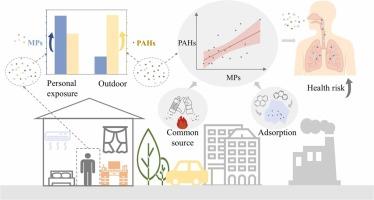个人暴露于PM2.5中的微塑料和多环芳烃:个人与室外评估和健康风险
IF 11.3
1区 环境科学与生态学
Q1 ENGINEERING, ENVIRONMENTAL
引用次数: 0
摘要
微塑料(MPs)和多环芳烃(PAHs)是环境中普遍存在的新兴污染物,其对健康的不良影响日益引起人们的关注。然而,由于方法上的挑战,对细颗粒物(PM2.5)中MPs特征的研究仍然很少。本研究采用热解-气相色谱/质谱法(Py-GC/MS)和气相色谱/质谱法(GC/MS)分别量化了中国大城市上海PM2.5中多磺酸粘多糖(MPs)和多环芳烃(PAHs)的人体暴露量。人体暴露MPs的平均浓度为2.27±2.31 μ m−3,明显高于室外水平(0.69±0.58 μ m−3)。在这两种环境中,聚乙烯(PE)是主要的聚合物,个人暴露样品显示出更高比例的聚对苯二甲酸乙二醇酯(PET)和聚苯乙烯(PS)。相对湿度对室外MP浓度有显著影响,而个人暴露MP水平主要受室内源和通风条件的影响。室外多环芳烃平均浓度(45.76±35.02 ng m−3)比室内多环芳烃平均浓度(30.67±8.67 ng m−3)高50%。聚丙烯(PP)和低分子量多环芳烃之间存在显著的正相关关系,表明它们可能被吸附或有共同的来源。估计每日摄入量(EDI)评估显示,多磺酸粘多糖的暴露水平高于多环芳烃,强调了深入了解可吸入多磺酸粘多糖/NPs及其添加剂的迫切需要。本文章由计算机程序翻译,如有差异,请以英文原文为准。

Personal exposure to microplastics and PAHs in PM2.5: Personal vs. outdoor assessment and health risks
Microplastics (MPs) and polycyclic aromatic hydrocarbons (PAHs) are pervasive emerging pollutants in the environment, raising growing concerns about their adverse health effects. However, research on characterizing MPs in fine particulate matter (PM2.5) remains scarce due to methodological challenges. This study quantified human exposure to MPs and PAHs in PM2.5 in Shanghai, a megacity in China, using pyrolysis-gas chromatography/mass spectrometry (Py-GC/MS) and GC/MS, respectively. The average concentration of personal exposure MPs reached 2.27 ± 2.31 μg m−3, which appeared to be higher than outdoor levels (0.69 ± 0.58 μg m−3). Polyethylene (PE) was the dominant polymer in both environments, with personal exposure samples exhibiting higher proportions of polyethylene terephthalate (PET) and polystyrene (PS). Relative humidity had a significant impact on outdoor MP concentrations, whereas personal exposure MP levels were primarily affected by indoor sources and ventilation conditions. In contrast, the average concentration of outdoor PAHs (45.76 ± 35.02 ng m−3) was 50 % higher than the personal one (30.67 ± 8.67 ng m−3). A significant positive correlation between polypropylene (PP) and low-molecular-weight PAHs suggests potential adsorption or common sources. Estimated daily intake (EDI) assessment revealed higher exposure levels to MPs than PAHs, underscoring the urgent need for an in-depth understanding of inhalable MPs/NPs and their additives.
求助全文
通过发布文献求助,成功后即可免费获取论文全文。
去求助
来源期刊

Journal of Hazardous Materials
工程技术-工程:环境
CiteScore
25.40
自引率
5.90%
发文量
3059
审稿时长
58 days
期刊介绍:
The Journal of Hazardous Materials serves as a global platform for promoting cutting-edge research in the field of Environmental Science and Engineering. Our publication features a wide range of articles, including full-length research papers, review articles, and perspectives, with the aim of enhancing our understanding of the dangers and risks associated with various materials concerning public health and the environment. It is important to note that the term "environmental contaminants" refers specifically to substances that pose hazardous effects through contamination, while excluding those that do not have such impacts on the environment or human health. Moreover, we emphasize the distinction between wastes and hazardous materials in order to provide further clarity on the scope of the journal. We have a keen interest in exploring specific compounds and microbial agents that have adverse effects on the environment.
 求助内容:
求助内容: 应助结果提醒方式:
应助结果提醒方式:


